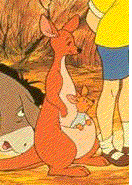

Kangaroo is a common name for certain marsupial animals found in Australia
and neighboring islands. Typical large kangaroos have sheeplike heads;
large, movable ears; slender chests; and heavy hind parts. They have short
front legs with five unequal digits, and long, powerful hind legs with
tendons that act like springs for energy-efficient hopping.
A large kangaroo can cover a distance of 9 m (30 ft) in a single leap.
The hind feet typically have four toes; one digit bears a long, sharp claw
used in defense. A large kangaroo, although ordinarily timid, is dangerous
when at bay, pummeling its attacker with its forepaws and slashing with
its powerful hind legs. The long, muscular tail is used as a support when
the animal sits or walks, and for balance when it leaps. The tough hide
is often covered with soft, woolly fur. Kangaroo hunting, for the animals'
hide and flesh, has been a popular sport in Australia, with hundreds of
thousands of the animals killed each year.
Female kangaroos, like the females of other marsupials, have special abdominal pouches. The newly born young, commonly called a joey, finds its way into the pouch unassisted by the mother. The pouch, in which the joey is kept until it is 5 to 9 months old (depending on species), contains four mammary glands, of which two at a time are functional. The joey emerges permanently at from 6 to 10 months, and then stays with its mother, continuing to suckle by placing its head in her pouch, usually until it is 12 to 18 months old.
"Kangaroo," Microsoft(R) Encarta(R) 96 Encyclopedia. (c) 1993-1995 Microsoft
Corporation. All rights reserved. (c) Funk & Wagnalls Corporation.
All rights reserved.
 Back
to Winnie The Pooh's Corner
Back
to Winnie The Pooh's Corner Back
to Winnie The Pooh's Main Page
Back
to Winnie The Pooh's Main Page Sign
My Guestbook
Sign
My Guestbook View
My Guestbook
View
My Guestbook Email
Me
Email
Me